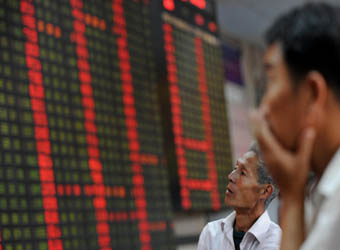Weak Chinese manufacturing data reinforced doubts over the health of global economies and pushed Asian shares lower on Thursday, as investors cautiously awaited a European Central Bank meeting that could see interest rates cut to support growth.
European stock markets were seen tracking Asian shares lower, with financial spreadbetters predicting London’s FTSE 100 .FTSE, Paris’s CAC-40 .FCHI and Frankfurt’s DAX .GDAXI would open down as much as 1 percent. .L.EU
U.S. stock futures were up 0.2 percent to suggest a firm Wall Street open. .N
The euro zone recession was behind mounting market expectations for the ECB to lower its main interest rate by 25 basis points to a record low 0.5 percent, while sluggish U.S. demand may be slowing China’s economic recovery.
On Thursday, the final HSBC China Purchasing Managers’ Index dropped to 50.4 in April from March’s 51.6 and a tad below a flash reading of 50.5, as new export orders fell for the first time this year.
Concerns about slow demand from China, Australia’s top customer and the world’s second-largest economy, weighed on Australia’s shares and currency while also hitting Chinese shares and Shanghai copper.
“The trend in the Chinese economy continues to improve and it has not lost momentum, but it is fragile and vulnerable to outside shocks, namely the U.S. economy which is showing signs of pausing,” said Hirokazu Yuihama, a senior strategist at Daiwa Securities in Tokyo.
“Market tone is dictated by the tug-of-war between growth prospect worries and support from sustained monetary stimulus. Weaker U.S. growth may prompt profit taking in Asian equities which have outperformed earlier this year, keeping regional markets in ranges,” Yuihama said.
MSCI’s broadest index of Asia-Pacific shares outside Japan .MIAPJ0000PUS fell 0.4 percent, with Australian shares .AXJO leading the decline as miners dragged the key index down 0.8 percent. The materials .MIAPJMT00PUS and energy .MIAPJEN00PUS sectors of the pan-Asian index led the drop.
Shanghai shares .SSEC were down 0.5 percent after earlier touching 2013 lows. A sharp slide for CNOOC (0883.HK) saw the Chinese oil major dragging Hong Kong’s Hang Seng Index .HSI down 0.5 percent. Shanghai copper fell nearly 5 percent to a session low of 49,240 yuan per metric ton (1.1023 tons).
U.S. crude futures pared earlier gains to trade nearly flat at $91.01 a barrel and Brent also was little changed at $99.97. <O/R>
“When you look at these numbers it shows growth, and that is really better when you compare it to what is going on in Europe,” said Carl Larry, president of the Houston-based Oil Outlook and Opinions, referring to the latest U.S. and Chinese factory activity data. “But the market is getting anxious as expectations are for these economies to be climbing a lot faster at this point in the year than they are.”
Japan’s Nikkei stock average .N225 slid 1 percent, heading for a fourth straight session of losses, which would mark the longest such losing run since November, just before Prime Minister Shinzo Abe starting making election-campaign promises of expansionary monetary and fiscal policies to spur growth.
Japanese financial markets will be closed on Friday and Monday for public holidays. .T
Fed Keeps Options Open
The dollar recovered from lows against a basket of six major currencies .DXY but stayed near its lowest since late February of 81.331 hit on Wednesday, after the U.S. Federal Reserve kept its plan to buy $85 billion in bonds each month, as was widely expected.
The dollar’s weakness lifted the euro to a two-month high of $1.3243 on Wednesday, but the common currency inched down 0.1 percent to $1.3167.
“Poor growth prospects remain a major deterrent to credit demand in the euro zone. The lack of credit demand points to further contraction in the region. This poor prognosis along with the disappointing read on Germany’s PMI in April should see the ECB ease policy,” Barclays Capital said in a research note.
The dollar fell 0.2 percent against the yen to 97.20, pressured by signs of weakness continuing in the second quarter.
A private ADP report on employment on Wednesday showed far fewer jobs created than forecast in April, prompting apprehension over the key government nonfarm payrolls data for April due on Friday. The U.S. economy likely added 145,000 jobs. March fell severely short of expectations at 88,000 — triggering a sell-off in riskier assets.
Also on Wednesday, a private U.S. factory activity gauge fell in March, with its employment index also declining.
“The feeling that the economy was subject to downside risks remained a feature, while the Fed hinted that it could alter the amount of its bond purchases in either direction in response to incoming data,” Andrew Wilkinson, chief economic strategist at Miller Tabak & Co in New York, said in a note to clients.
After its two-day meeting ended on Wednesday, the U.S. central bank cited risks to growth from recent budget tightening in Washington and reiterated that unemployment is still too high for policymakers’ comfort.
Reuters
